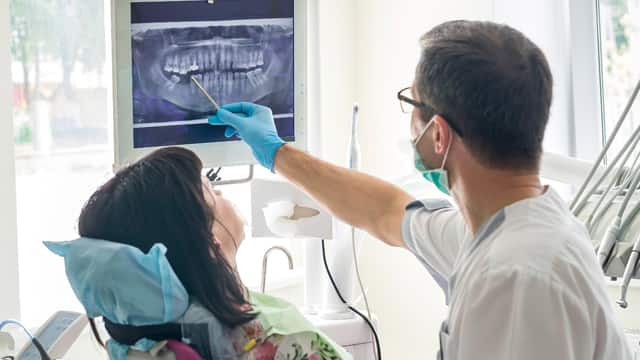By recognizing the symptoms and getting the correct diagnosis, you can successfully treat a mandibular fracture. And that's great news! After all, you want the only movable bone in your head to function fully so you can eat, talk, sing, cheer, and smile. In other words, enjoy life.
Symptoms of Mandibular Fractures
A mandibular fracture is similar to a bone fracture in any body part. The bone becomes stressed, usually from excessive force, and breaks under that pressure. Beyond accidents, mandible fractures can result from violence. In fact, most U.S. adults experience such trauma because of a violent act, reports research published in the Seminars in Plastic Surgery journal.
Jaw fracture symptoms you might experience include:
- Pain, swelling, redness, and increased heat in the jaw or ear area
- Difficulties speaking, chewing, and breathing
- Numbness or bruising of your face and neck
- Loose teeth or change in teeth alignment
- Bleeding from the mouth
If you think you have a broken mandible, it's crucial to visit a medical or dental professional as soon as possible for a diagnosis. If the symptoms are severe, it's in your best interest to have someone drive you to the emergency room – or call 911.
Diagnosing Mandible Fractures
After a physical check of your jaw and face, you'll undergo a radiograph to detect jaw fracture(s) resulting from the injury. Maxillofacial radiologists – doctors who specialize in reading dental radiographs – access the presence and severity of cracks, splits, or complete breaks.
A Journal of Oral and Maxillofacial Radiology report notes two types of radiographs that best identify mandibular fractures:
CT Scan: A special type of radiograph called cone-beam computer tomography (CBCT) allows maxillofacial radiologists to assess bone conditions and fractures in three dimensions with 100 percent accuracy. Since you might have more than one fracture, it's important to pinpoint all fractures.
X-ray: A lower-price option is a panoramic X-ray that can detect 86 percent of mandibular fractures.
If you live in a community without this radiographic equipment, you might undergo a regular CT scan or X-ray initially. But you'll do yourself a favor by making arrangements for a CBCT scan before treatment begins.
Who Treats Mandibular Fractures
After being diagnosed with a broken jaw, you'll typically receive a referral to a specialist for further treatment. Most likely, you'll see an oral and maxillofacial surgeon who'll determine the best plan to do these two things at the same time:
- Heal the jawbone.
- Restore the proper bite pattern, or occlusion, of the teeth.
If your teeth are improperly aligned as your jaw heals, you might have future issues with temporomandibular joint pain.
Treatment of Mandibular Fractures
Mandibular fracture treatment depends on the severity, the location, and the number of jaw fractures. Treatments can include:
Resting your jaw. This requires you to avoid opening your jaw except to consume – but definitely not chew – soft foods and liquids.
Wiring your mouth closed. This stabilizes your jaw joints as the bones heal. And, yes, a liquid diet will make up your meal plan.
Surgery for more severe breaks. This might involve screwing metal plates into the jawbone. Again, so your jaw remains stable, wiring your mouth closed might be required. And, again, a liquid diet might be on the menu.
Treatment and recovery can require up to four to six weeks for your fracture to heal. During this time, you'll typically receive prescriptions or advice to take:
- Anti-inflammatory medications to increase your comfort and aid in your healing.
- Antibiotics to prevent an infection of the bone.
To rebuild your jaw muscles and joints' strength, you'll likely need to undergo physical therapy.
Good oral hygiene is crucial during healing, but wires and a limited mouth opening will impair your ability to brush. Your dentist may recommend that you swish with an antibacterial mouthrinse.
If you experience trauma to the jaw, don't hesitate to seek a diagnosis and treatment for a broken mandible – even if you don't experience obvious symptoms. And though you might have to wait up to six weeks before eating solid food again, it'll be something to smile about once your jaw and bite start working properly again.
Oral Care Center articles are reviewed by an oral health medical professional. This information is for educational purposes only. This content is not intended to be a substitute for professional medical advice, diagnosis or treatment. Always seek the advice of your dentist, physician or other qualified healthcare provider.
ORAL HEALTH QUIZ
What's behind your smile?
Take our Oral Health assessment to get the most from your oral care routine
ORAL HEALTH QUIZ
What's behind your smile?
Take our Oral Health assessment to get the most from your oral care routine
Join Us
Get the best of your oral health routine and take it to the next level with expert advice, recommendations, products and solutions and special offers.
Join Us
Get the best of your oral health routine and take it to the next level with expert advice, recommendations, products and solutions and special offers.















